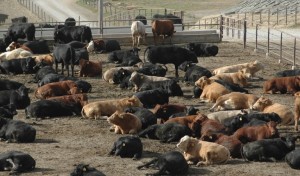Cattle are the main reservoirs for Shiga toxin–producing Escherichia coli (STEC) strains. E. coli O26, O45, O103, O111, O121, O145, and O157 are among the STEC serogroups that cause severe foodborne illness and have been declared as adulterants by the U.S. Department of Agriculture, Food Safety and Inspection Service.
 The objectives of this study were (i) to estimate the prevalence of non-O157 STEC and E. coli O157 in naturally infected beef cows and in steer calves at postweaning, during finishing, and at slaughter and (ii) to test non-O157 STEC isolates for the presence of virulence genes stx 1, stx 2, eaeA, and ehlyA.
The objectives of this study were (i) to estimate the prevalence of non-O157 STEC and E. coli O157 in naturally infected beef cows and in steer calves at postweaning, during finishing, and at slaughter and (ii) to test non-O157 STEC isolates for the presence of virulence genes stx 1, stx 2, eaeA, and ehlyA.
Samples were collected from study animals during multiple sampling periods and included fecal grabs, rectal swabs, and midline sponge samples. Laboratory culture, PCR, and multiplex PCR were performed to recover and identify E. coli and the virulence genes. The prevalence of non-O157 STEC (serogroups O26, O45, O103, O111, O121, O113, and O145) fecal shedding ranged from 8% (4 of 48 samples) to 39% (15 of 38 samples) in cows and 2% (1 of 47 samples) to 38% (9 of 24 samples) in steer calves. The prevalence of E. coli O157 fecal shedding ranged from 0% (0 of 38 samples) to 52% (25 of 48 samples) in cows and 2% (1 of 47 samples) to 31% (15 of 48 samples) in steer calves. In steer calves, the prevalence of non-O157 STEC and E. coli O157 was highest at postweaning, at 16% (15 of 96 samples) and 23% (22 of 96 samples), respectively.
Among the 208 non-O157 STEC isolates, 79% (164 isolates) had stx 1, 79% (165 isolates) had stx 2, and 58% (121 isolates) had both stx 1 and stx 2 genes. The percentage of non-O157 STEC isolates encoding the eaeA gene was low; of the 165 isolates tested, 8 (5%) were positive for eaeA and 135 (82%) were positive for ehlyA. Findings from this study provide further evidence of non-O157 STEC shedding in beef cows and steer calves particularly at the stage of postweaning and before entry into the feedlot.
Journal of Food Protection®, Number 7, July 2014, pp. 1052-1240, pp. 1052-1061(10)
Ekiri, Abel B.1; Landblom, Douglas2; Doetkott, Dawn3; Olet, Susan4; Shelver, Weilin L.5; Khaitsa, Margaret L.6
http://www.ingentaconnect.com/content/iafp/jfp/2014/00000077/00000007/art00001
